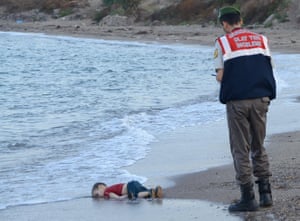It was very important to us that we placed Aylan’s death in context, with some serious reporting about what happened to him and the broader picture of current political and social attitudes towards refugees across Europe, particularly in Britain and Germany. I still think it was right to use the pictures, but I might be wrong about that, and I’m aware that good intentions and serious intent are not always enough. – The Guardian
The boy– Aylan Kurdi is not just ‘the Syrian boy who drowned’ in early September. The context of the image was to illustrate the sadness of the refugee situation. However, it became an outcry for what seems to be all lost children of such tragedies. The author upon our search was not found but what was listed was newspapers from various regions in European that used the photograph when the story first broke, but to our research the first actual person who took and posted the picture could not be found.
The visual imagery appeals to the ethos of a person by not only the raw nature of the image but also the questions it rises such as: how many more children have died this way? and how many of these stories go untold?
This image went viral due to the fact that we believe it contained an innocent child who encapsulates the fight and struggle of the refugee epidemic. It circulated based on this heartbreaking fact that he had not only lost his home but now his life too due to this situation. As the image circulate we attached our own meaning and in doing so create our own story as to why this is relevant to our culture or even why it is relevant to read.
The meanings the picture took on were both negative and positive in cases. For instance, people took the image as a way to be proactive and pay tribute while others created memes mocking and taunting the situation.
When it came to researching the image and story it was shockingly simple due to the fact that all we had to search was ‘Syrian boy drown’, and in a fraction of a second we were flooded with millions of stories and images. This not only shows how much the story circulated and its virality.








